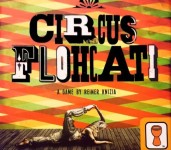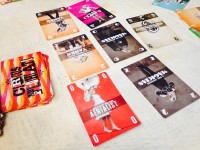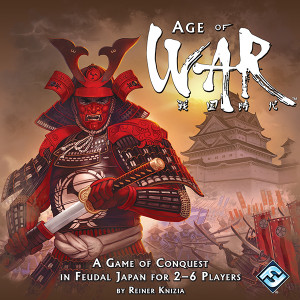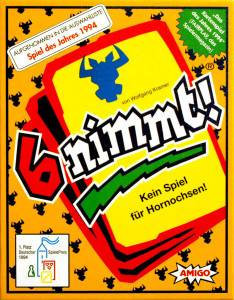- Learning time
- 5 minutes
- First play time
- 20 minutes
Circus Flohcati
Designed by: Reiner Knizia
Circus Flohcati is a fifteen-minute card game of pushing your luck – but it’s not all about chance, as we’ll see…
Setting up the game couldn’t be simpler: shuffle all the cards and put them in the centre of the table. The cards come in eight colours and each colour has eight numeric values, from zero to 7.
The first player flips over the top card. They now have a choice – they can take the card they’ve just flipped into their hand, or flip another from the deck. In fact, they can flip as many cards as they like, but as soon as they flip a card that’s the same colour as a previously flipped card, they effectively go bust and can’t take anything. (For the rest of the game players may choose to take previously flipped cards – assuming there are any – instead of flipping another.)
…So why not just take the first card? Well, that’s certainly an option and that tactic would avoid you going bust. But what you’re trying to do with the cards is make trios of numbers – a set of three of any number is a trio and you can choose, at the end of your turn, to lay these to the table. They’ll score you ten points at the end of the game, and if you manage to get trios of all the numbers played onto the table (called a Gala) the game ends instantly and everybody scores. If nobody calls a Gala, you simply play until all the cards form the draw deck have run out.
Scoring is as follows: Trios (no matter what their numeric value) played to the table are worth ten points. A player calling a Gala scores a bonus ten points. Cards in your hand are worth points too; you score the highest numeric value card of every colour you have, and ignore everything else.
So the game offers you a dilemma: Are you going to try and get the guaranteed 90 point Gala, or are you going to try and populate your hand with high numbers to score at the end of the game? Three sevens as a trio is worth ten points whereas in your hand they are worth 21… but while they’re in your hand, they’re not helping you get a gala which ends the game with a ten point bonus for you. It’s a clever game with more to it than first appears, including the three Action cards that will occasionally pop up, allowing you to steal cards from each other, or draw a bunch of cards with no penalty.
The guru's verdict
-
Take That!
Take That!
Not a great deal, but the Take That factor is certainly there. You can literally take a card you know someone else wants.
-
Fidget Factor!
Fidget Factor!
Low to non-existent. Everyone is collecting cards.
-
Brain Burn!
Brain Burn!
Not much. But there's some risk-taking that you shouldn't be doing blindly...
-
Again Again!
Again Again!
Randomness is assured thanks to the cards, but you can also take a different tack when you play.









Sam says
It's so simple, but so canny. I think the cards look great, too. And if you like the kind of dilemmas this designer gives you but want something more complex, consider checking out Samurai, Taj Mahal, or even - for a real ding-dong - Tigris and Euphrates.